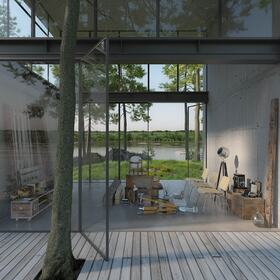
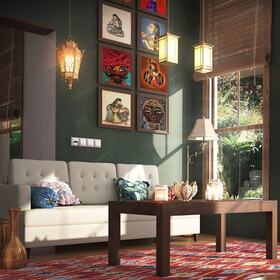
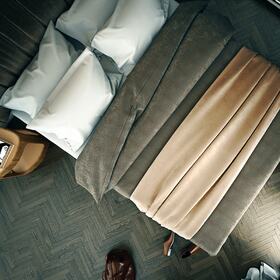
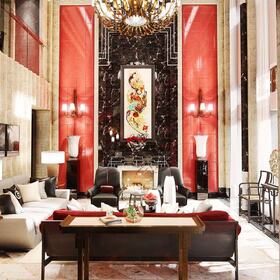
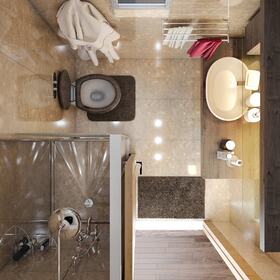
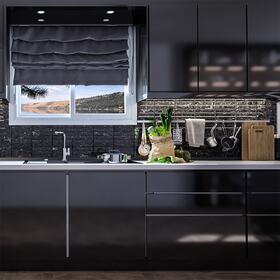
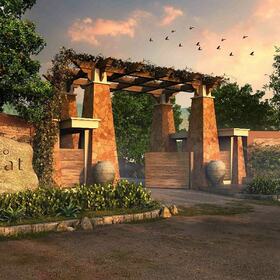







Cad Crowd’s experienced freelance designers can capture and display stunning 360-degree panoramic images optimized for any platform. Viewers can navigate professional 3D panoramic renderings using a desktop, laptop, tablet, mobile phone, or virtual reality tools such as Google Cardboard and Oculus Rift. Using high-tech cameras and 3D rendering software, we create custom panoramas that can be embedded into websites or social media for an immersive 3D experience.
The use of 360-degree panoramas is essential in industries like architecture and interior design. In addition, 360° images have other fundamental uses for applications like entertainment, education, science, manufacturing, and product photography. Tech giants like Google, Facebook, HTC, and Samsung are starting to market 360° videos. No matter what your 360° rendering needs, Cad Crowd will provide you with a 100% free and personalized consultation. We’ll find the right 3D rendering pro for your 360-panorama project.
The most frequent market for 360° rendering is in architecture and landscape design services. Architects and designers use 360-degree panoramas to ‘walk’ their clients through spaces before it’s built. In addition, capturing real estate in full 360° enables designers, builders, salespeople, and clients to view the big picture with far less distortion. It’s the superior option for designing, building, promoting, selling, or renting real property.
Virtual reality gaming is undoubtedly the first thing to mind when considering 3D panoramic entertainment. However, social media platforms like Facebook and YouTube provide 360-degree panoramas for business and leisure. Most recently, VR goggles like Google Cardboard or Oculus Rift have provided consumers with high-quality, immersive, 3D-panoramic entertainment like films, TV, and games. Cad Crowd offers metaverse gaming design services.
An immersive and engaging VR environment allows educators in many fields to reach an increasingly diverse group of students. Medical, health, and sports science schools use virtual reality to teach anatomy and physiology. Other fields that use VR-assisted learning include marketing, architecture, clinical education, computer science, and paramedics.
Spherical panoramas are used in manufacturing for VR prototype design services and factory floor plan design services. Ford Motor Co. was one of the first manufacturers to incorporate VR into its design and manufacturing workflow fully. The company employs VR specialists in all aspects of its operations. Ford’s engineers can design and build an entire car inside a custom VR environment, from the powertrain to the upholstery.
VR product photography, also known as 360° Object VR, 360° product photography, or a 360-degree product view, displays objects often used for e-commerce. In VR photography, the camera stays fixed while the object rotates around it. The designer then stitches together the series of resulting JPEGs with software. Cad Crowd’s custom design professionals can create elaborate panoramic product images using photography, 3D visualization services, 3D rendering, or a combination of photography and 3D rendering.
Send us your project description today. We work with every industry to analyze project requirements and connect you with freelance CAD design services to realize your 360-degree 3D panorama projects.
Many different terms describe 360° panorama. You may hear the terms panoramic rendering, 360-degree rendering, stereoscopic rendering, panorama imaging, 360-degree, or monoscopic rendering. Sometimes, a panorama is called a wide-angle or ultra-wide-angle shot. Essentially, ‘panorama’ means any wide-angle representation in painting, drawing, photography, film, scientific visualization, or 3D rendering.
Most recently, 360° is the trending term, but the idea of the panorama has existed since ancient times. For example, the Roman murals at Pompeii portray wide-angle landscapes from an aerial perspective. European mapmakers have also long experimented with panoramic charts, while Chinese artists created stunning panoramic landscapes during the Song Dynasty (960 – 1279).
Panoramic imaging was particularly popular in 18th-century Europe. The English word panorama was coined around 1787 (from the Greek words πᾶν "all" + ὅραμα "sight") by English painter Robert Barker. Barker exhibited his wide-angle paintings of Edinburgh and London using an invention he called an ‘Apparatus for Exhibiting Pictures.’ It was a painted cylindrical surface meant to be viewed inside a small, purpose-built structure.
Barker’s panorama idea was so popular that in 1793, he was invited to build a tourist attraction, "The Panorama," in London’s Leicester Square. For over 70 years, Barker’s panorama entertained London residents and visitors alike. It was an exciting spectacle but had limitations: It couldn’t fix an image to a surface, nor was it portable. The Austrian Joseph Puchberger did the first recorded patent for a panoramic camera in 1843. Puchberger patented a hand-crank, swing-lens camera that used silver-coated copper plates to produce fixed photographs.
As for its panoramic capabilities, Puchberger’s camera was limited to a 150-degree view, but it wasn’t long before a full 360-degree camera arrived on the scene. Within ten years of Puchberger’s patent, M. Garrela of England invented a camera that rotated 360° around its axis using clockwork mechanics. Soon after, panoramic cameras using flexible film were developed in Europe and the United States. The Cirkut by the Rochester Panoramic Camera Company was the most popular.
Kodak bought the Cirkut and marketed it for most of the first half of the 20th century. By the 1970s and 1980s, having emerged as the world leader in imaging technology, Kodak brought panoramic imaging to the next level with multi-image 35mm slide projection. By precisely overlapping multiple slides during projection, consumers and businesses could achieve excellent panoramic results. Cutting and dissolving with specialized technology could generate even more impressive animated effects.
Since the 1990s, most digital imaging has worked similarly to Kodak’s multi-slide technology with ‘image stitching.’ Image stitching is supported by environments like Apple's QuickTime VR, Flash, Java, and JavaScript. Rotating cameras such as the state-of-the-art Panoscan eliminate some need for image stitching. However, image stitching software still creates most “spherical" panoramic films incorporating a full 180° vertical view and 360° panorama.
With the depth of experience and know-how you need, Cad Crowd’s CAD designers can handle any 360-degree 3D panorama project. Our developers offer everything from 3D flythrough services to 3D interior visualization services.
Nowadays, all you need to produce consumer-quality panoramic images is your smartphone. Phone-based cameras can snap 8, 10, 12, or 14 slices of a scene and then use photo stitching to assemble those slices into a single rectangular image. Most panoramic smartphone images are limited, however. They’re called "cylindrical" views because they allow complete 360° panning but only have a vertical view of about 50°.
Cad Crowd’s freelance CAD professionals can use techniques like rectilinear stitching with a DSLR if you're looking for more advanced digital photography. In rectilinear stitching, a digital camera rotates up and down. The photographer stops it at intervals such as 40°, 60°, or 90°. This way, an expert designer can capture a complete panorama using the highest-quality imaging.
Image stitching has one limitation: It’s an arduous process for image stitching to capture moving subjects like cars or people. Consumers and specialists use one-shot panoramic optics like multi-headed cameras or purpose-built glass for subjects in motion. Some up-to-the-minute examples include the Insta360, Egg Solution, or Sphere. New technologies that produce high-quality, one-shot, 360° images on DSLRs or smartphones are constantly emerging.
Tell our designers what you envision for your project, and we’ll help you select the best option for your 3D 360-degree panoramic imaging project. Get a free quote from Cad Crowd today!
Our freelance CAD specialists offer 3D rendering services to produce professional panoramic renderings using 3D rendering software or a combination of 3D rendering and photography. Look at the technical steps a skilled Cad Crowd designer might take to create stunning 3D panoramas with tools like Blender, 3ds Max, and VRay. If you need help with your 3D 360-degree panorama project, follow this link for a free consultation!
Setting up a scene for 360° rendering is like a typical scene. Cad Crowd offers 2D to 3D modeling services, 3D modeling services, and architectural 3D modeling services to render your scene as necessary. Then, they’ll use specialized skills to optimize your rendering for large panoramic resolutions of up to 6000 x 3000 with a 2:1 aspect ratio. When modeling, texturing, and lighting a scene meant for panoramic rendering, it helps to trust a pro. A 360-degree panorama will contain flaws if the objects are modeled for one-point viewing.
Cad Crowd can hand-pick an experienced designer who will test-view your images from multiple angles. While in a V-Ray Physical Camera, for example, your freelance developer will use a walkthrough mode to inspect the rendering using a high-quality 360-degree display.
Once your experienced Cad Crowd developer has modeled and tested a scene, they’ll typically proceed with the following steps in software like Blender:
A native 3D panoramic rendering tool called Panorama Exporter is available in 3ds Max. It uses image stitching to take several images from a developer-defined camera and combine them into a spherical map. In this case, your skilled Cad Crowd professional will define the camera and then boost the output resolution to 6000 x 3000 pixels, again with that 2:1 aspect ratio. Software like 3ds Max can produce excellent 360-degree 3D panoramic results without needing third-party plugins like VRay.
VRay is the most popular commercial 3D rendering plugin for third-party graphics software like 3ds Max, Autodesk Revit, Cinema 4D, Maya, Modo, Nuke, Rhinoceros, Sketchup, Softimage, Blender, and more. At Cad Crowd, we can connect you with a world-class VRay expert who will flawlessly render your 360° panorama! Contact us for a free quote.
Here’s how Cad Crowd’s pro developers would typically work with 360 in VRay:
Because over-editing can cause mismatched seams in a panoramic image, Cad Crowd advises clients to keep the post-processing of 360° photos to a minimum. That said, there are post-production options that can perfect and optimize every image. Contact us today, and Cad Crowd will find the perfect candidate to advise you on your post-production needs.
Having trouble with your project? Don’t have time to juggle all the tasks on your to-do list? Get a free quote from Cad Crowd, and we’ll connect you with an industry-leading 360-degree 3D panorama expert today!
Rendering a 360° view is only part of developing state-of-the-art professional 3D panoramas. There’s a crucial second step: Your panorama must reach its intended audience! Cad Crowd’s roster of skilled CAD developers can help move your project from concept to delivery using a 360° panorama app, website, and social media integration. This can involve editing metadata for the web or social media or seamlessly integrating your file using best practices for various VR viewers. Drop us a line for a free consultation.
To post a 360-degree render on a website or send it to a client to view inside a browser, our CAD designers will often use a tool like MarziPANO. Uploading your render to a tool like MarziPANO creates a downloadable HTML package containing all the files necessary for 360° image viewing. We can also help you use GoPro VR Player or sites like 360player.io to instantly process and display your 360° renderings.
To add a 360° to Facebook, Cad Crowd’s expert freelance designers can edit your image’s metadata. The image must have a 2:1 aspect ratio. Then, in the details tab, select the camera’s make and model (or any make and model) and upload your panorama like any other image. Our CAD designers can help you with a metadata editor like thexifer.net.
For YouTube, Cad Crowd’s freelance developers can use professional video editing software to prepare 360-degree renderings for upload. Most video editing packages can import a panorama using a 2:1 aspect ratio. Your designer will then set the desired length of the video and export it as a .mp4. After adding Google’s 360 video metadata, your video is ready for YouTube! By reading the embedded metadata, YouTube will recognize your project as a 360-degree interactive video.
Panoramas are fun to view on a desktop computer, but viewing 360-degree images on mobile devices is becoming increasingly popular. You can navigate 3D panoramic renderings on a mobile device using free and simple apps like 360 Panorama Viewer or find 3D virtual reality rendering services. If your phone has a gyroscope, you can use Google Cardboard with an app like PSViewer or WEBVR. Serious users can invest in VR goggles like Oculus Rift or the mobile Oculus Go to view and interact with 360° virtual reality renderings.
What is Google Cardboard? Google Cardboard works to bring immersive experiences to anyone with a gyroscope-equipped smartphone, and its most attractive feature is its price! It’s open source so that manufacturers can build their unique versions. Models range from fold-your-own for $7 to $60 for various bells and whistles. Still, they all work the same: By placing your phone at the correct distance from the lenses and using the appropriate apps, Google Cardboard creates a VR effect when viewing panoramic images.
Still unsure about which option you should use for displaying your 360-degree panoramas? Connect with Cad Crowd today, and we’ll help you choose the best display options for your 360° panorama project.
If you’re looking for something more upscale, Oculus Rift is a VR-compatible headset manufactured by Oculus VR, a division of Facebook. The Rift was launched in 2016. It boasts two Pentile OLED displays, a 90 Hz refresh rate, a 110° field of view, and rotational and positional tracking with integrated 3D headphones. Oculus VR is developing the Rift with the idea that social applications will be the most popular VR trend. The Oculus Rift is focused on gaming, education, cinema, and sports, but interest in the industry has also been strong.
Cad Crowd has helped thousands of clients realize their visions with our 3D CAD design services. We’ll help you find an expert CAD designer to transform your idea into a 360-degree 3D panorama design. Our contractors are experts in architectural rendering, landscapes, interiors, MEP, manufacturing, virtual tours, 360-degree product views, and more! We’re standing by to chat about your project’s custom requirements.
Using 360-degree panorama in your company’s products can optimize productivity. Because they allow the viewer to explore an image as though they were in a virtual space, just one 360º panorama can replace multiple photos that you and your designers might have otherwise had to produce. This way, 3D panoramas enhance workflow productivity for designers, educators, scientists, manufacturers, engineers, marketers, product photographers, and more!
Not only that, but because 360º images place the viewer directly into the scene, they’re the superior method for conveying information about orientation, distance, relative size, materials, and height. Clients and customers can enhance their experience of your products by rotating their view and exploring the content at their own pace.
For design and manufacturing, a 360-degree rendering is a great way to help your company visualize materials and clashes that aren’t readily viewable in a plan. A 360º rendering makes technical decisions faster and easier by allowing your team to assess real-world materials.
Get a free quote now. Cad Crowd’s CAD experts will analyze your project requirements and connect you with industry-leading designers ready to work with you to bring your 360-degree 3D panorama products to life.
Whether you need one designer or one hundred, Cad Crowd provides the freelancers you need for all your 3D 360° panorama projects. We work with every industry to maximize productivity and enhance the quality of your workflow with top-notch 3D 360°panoramic renderings.
The use of CAD in your daily tasks makes a better product. At Cad Crowd, we’ll connect you with experienced drafters, architects, engineers, and designers to help your project get underway. Cad Crowd will find the right contractor to render your panoramic images and convert them for viewing on optimal platforms. The result? Happy and engaged customers! Get in touch for your free quote. At Cad Crowd, we’re always ready to advise you on all your 3D rendering needs.

